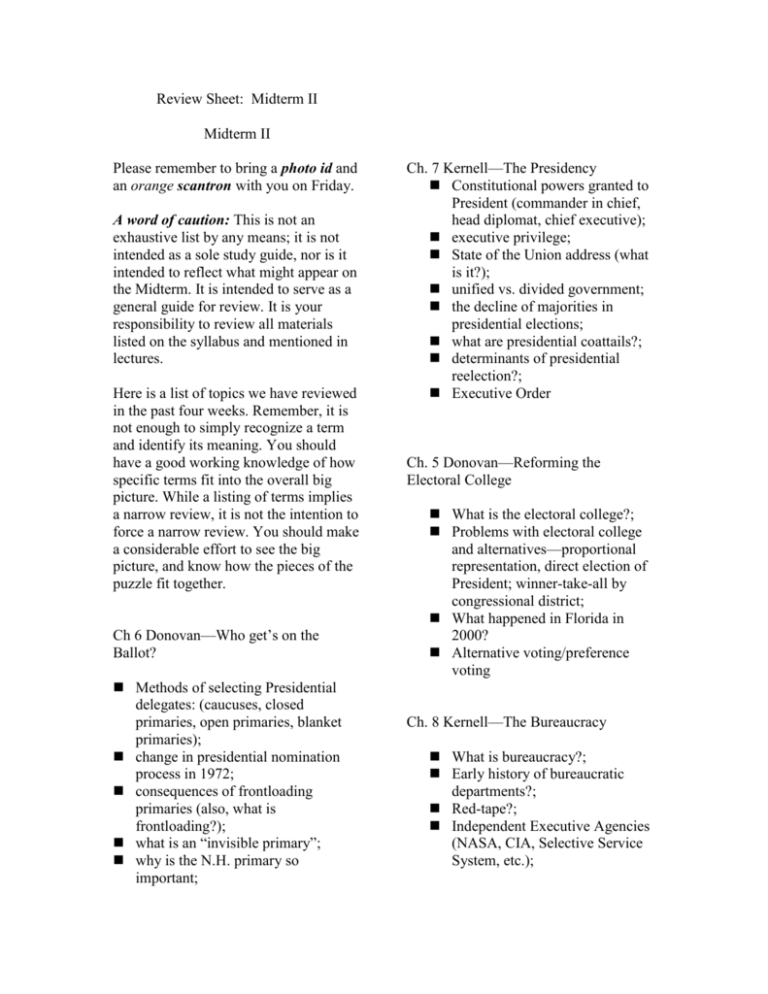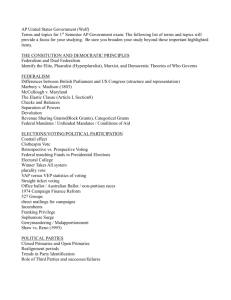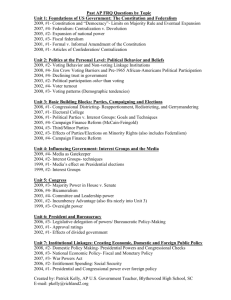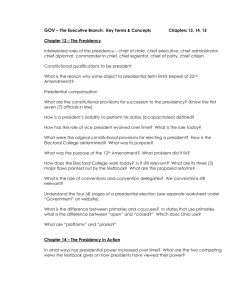Review Sheet: Midterm II
advertisement

Review Sheet: Midterm II Midterm II Please remember to bring a photo id and an orange scantron with you on Friday. A word of caution: This is not an exhaustive list by any means; it is not intended as a sole study guide, nor is it intended to reflect what might appear on the Midterm. It is intended to serve as a general guide for review. It is your responsibility to review all materials listed on the syllabus and mentioned in lectures. Here is a list of topics we have reviewed in the past four weeks. Remember, it is not enough to simply recognize a term and identify its meaning. You should have a good working knowledge of how specific terms fit into the overall big picture. While a listing of terms implies a narrow review, it is not the intention to force a narrow review. You should make a considerable effort to see the big picture, and know how the pieces of the puzzle fit together. Ch 6 Donovan—Who get’s on the Ballot? Methods of selecting Presidential delegates: (caucuses, closed primaries, open primaries, blanket primaries); change in presidential nomination process in 1972; consequences of frontloading primaries (also, what is frontloading?); what is an “invisible primary”; why is the N.H. primary so important; Ch. 7 Kernell—The Presidency Constitutional powers granted to President (commander in chief, head diplomat, chief executive); executive privilege; State of the Union address (what is it?); unified vs. divided government; the decline of majorities in presidential elections; what are presidential coattails?; determinants of presidential reelection?; Executive Order Ch. 5 Donovan—Reforming the Electoral College What is the electoral college?; Problems with electoral college and alternatives—proportional representation, direct election of President; winner-take-all by congressional district; What happened in Florida in 2000? Alternative voting/preference voting Ch. 8 Kernell—The Bureaucracy What is bureaucracy?; Early history of bureaucratic departments?; Red-tape?; Independent Executive Agencies (NASA, CIA, Selective Service System, etc.); Independent Regulatory Commissions (FDA, OHSA); independent governmental corporations; Cabinet agencies; Spoils System Ch 10 Kernell—Public Opinion How do you measure public opinion?—scientific v. nonscientific polls, straw polls, the logic of probability sampling; ideology; liberal v. conservative—know each group’s view of the role of government, e.g., how they view individual equality; right v. left; how do people acquire their political beliefs? Political socialization Measurement error Foreign Policy Lecture—Oct. 20th What is foreign policy and what are its determinants?; who are the internal/external actors in foreign policy formulation? (know the different categories and examples of each); executive and congressional powers in foreign policy and know how this dichotomy contributes to “checks and balances”; War Powers Act; know the different instruments of F.P. Ch. 11 Kernell—Voting Know the different periods of expanded suffrage, e.g. women, African Americans, young Americans; Who votes—who’s represented, underrepresented and overrepresented?; How do voters decide who to vote for—issue voting, performance voting, single issue voting, party labels, party identification? Negative campaigning; efforts to regulate campaign donations—past legislation, court cases; hard v. soft money; who does the money predominantly go to; know the different voting models—Michigan and Retrospective Voting Models; swing voters. Focus group Access






